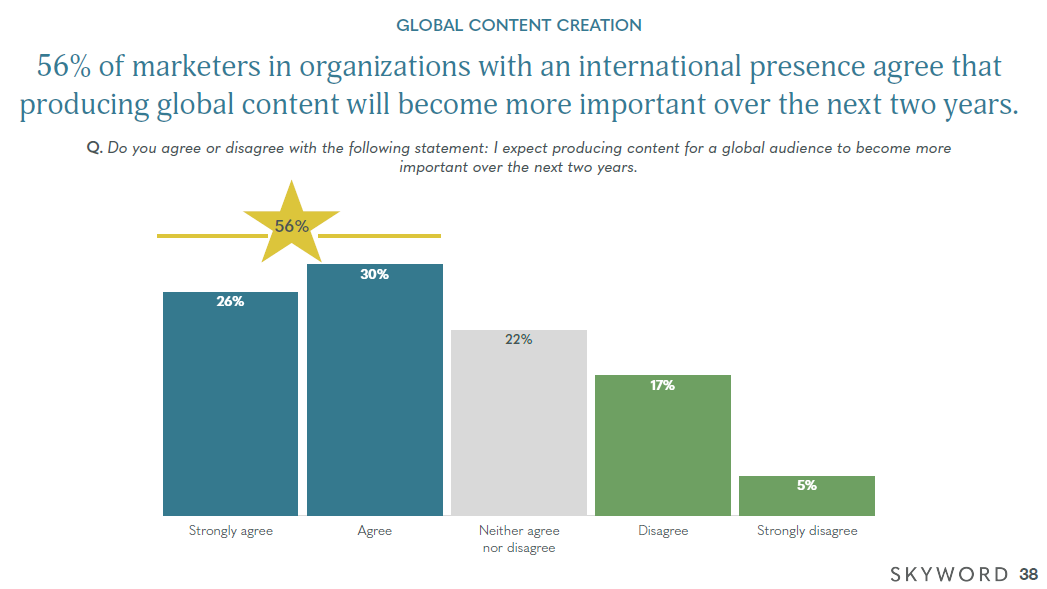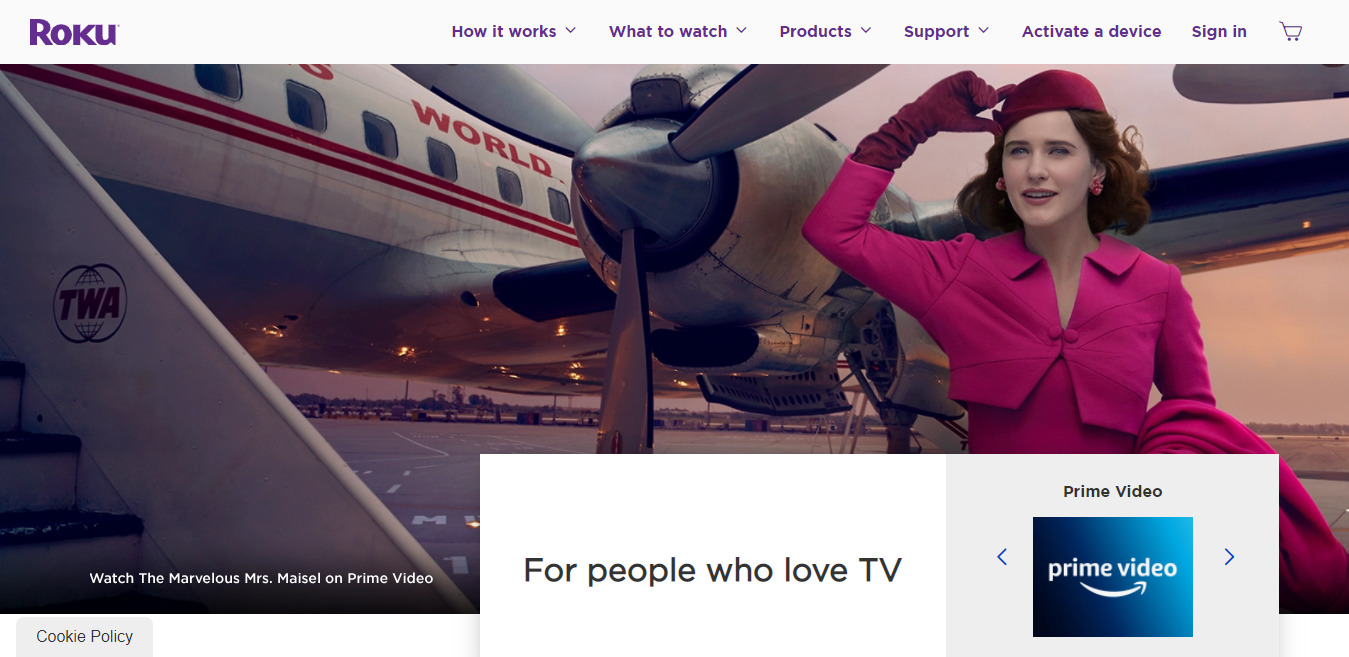Content Creation
The 5 Do’s and Don’ts of Global Content Creation and Transcreation
By Simki Dutta on September 8, 2020
As a global brand, one of the biggest mistakes you can make is using the umbrella approach when creating content. While you want your brand to offer a consistent experience to users, it also needs to appeal to regional markets and engage local audiences. Skyword's 2020 Content Marketing Trends report reaffirms this.
In surveying B2B and B2C marketers representing organizations with international presences, Skyword found that 56 percent of respondents agreed on one thing: Global content creation will become more important over the next two years. The report also shows that among marketers who create global content, 80 percent plan to adapt assets intended for the United States for other regional markets.

But what does adapting content for global markets, a process also referred to as transcreation, entail? And is there a right way to go about it? Pepsi famously learned the hard way what not to do when they entered the Chinese market with this slogan: Pepsi brings you back to life. They failed to realize that when the slogan was translated into Mandarin, it actually read as, "Pepsi will bring your ancestors back from the dead."
If there's a lesson to be learned from this and other recurring anecdotes of miscommunication, it's that merely translating content—or, worse, relying on machine translation—isn't the key to high-quality global content. Succinctly put: When done well, transcreation will make sure those dead ancestors don't show up anywhere in your content marketing.
Rather than woodenly converting messages from one language to another as Google translate would do, transcreation reanimates your content for regional markets while being sensitive to cultural nuances and norms. Successful transcreation ensures content is:
- readable.
- technically accurate.
- adapted to its target market.
- aligned with accurate sourcing and imagery.
- optimized for local search.
Transcreating allows you to deliver content that is relatable and evokes an emotional response in local audiences, helping you meet them where they are—wherever in the world that may be. Once you've made adapting assets to a global audience part of your overall content marketing plan, here's how to effectively localize each piece.
Prioritize Assets To Be Transcreated
Let's face it: Transcreating is a commitment. It requires ample time, money, and effort. A smart way to go about it is to start by prioritizing pieces to transcreate.
You should choose content based on its relevancy and performance. For instance, if a particular blog post is performing well among your U.S. audience, transcreating and localizing it for regional markets makes good sense. Similarly, if a piece of content feels highly relevant to a particular market, transcreating it allows you to optimize your return on the initial investment.
Don't: Waste time transcreating technical, legal, and internal documents. Instead, focus your efforts on customer-facing content and marketing collateral.
Develop a Detailed Creative Brief
From the local and global marketing teams to the transcreator and proofreader, there are lots of people who take part in the transcreation process. That means there's ample room for miscommunication. To improve collaboration and minimize chances for misunderstandings, you'll want to have detailed creative briefs that include:
- content goals or objectives.
- target audience overviews.
- brand backgrounds.
- brand guidelines.
- key messaging.
- sourcing, visual, and SEO guidelines.
A well-written creative brief and efficient content workflow set clear expectations, maintain accountability, and ensure everyone's on the same page.
Don't: Forget to specify which words don't need to be translated, such as product or service names.
Work with Native Language Writers
Transcreation takes a lot more than just changing words. It's about delving deeper into the regional markets and understanding the target audience, all while taking into account their needs, emotions, and cultural nuances. Considering how layered of a job transcreation is, it makes sense to work with native language writers. They will likely have a better understanding of the language and its idioms, phrases, colloquialisms, references, expressions, and other nuances.
Don't: Count on verbatim translation to convey the context and intent of your content.
Perform Local Keyword Research
As SEO goes hand in hand with global content creation, the same holds true when transcreating content for regional markets. You must identify the target keywords that would help your content rank higher in local search results. Performing local keyword research also helps you identify the challenges of your target audience, which allows you to create content that better bridges the gap.
Let's say you optimized a blog post in English for the keyword "visual content marketing." You can't simply do the same when you're transcreating the blog post in Spanish, as the keyword might not be the most comparable phrase. Instead, you'll need to do local keyword research to find more accurate phrases with considerable search volume in the Spanish market.
Don't: Forget to optimize your content for search engines other than Google, such as Bing, Yahoo, Naver, and Baidu among others that might be more popular in a particular region. For instance, Yandex (not Google) is the leading search engine in Russia.
Select Suitable Imagery
While global content creation involves transcreating the text, it's equally important to ensure the supporting imagery is in line with the local market's sensibilities. You strive for the perfect visual to communicate your message effectively, but what happens when the image doesn't manage to evoke the right emotions or, worse, comes across as offensive? This is where image localization comes into the picture.
Opt for suitable imagery that speaks to your local target audience and is familiar to them. One brand that does image localization well is Roku. They highlight different imagery to reflect the shows that are popular among their respective audiences, thereby compelling users to take the desired action. Notice how their "What to Watch" page differs in the U.S. and France versions.

Image attribution: Roku's U.S. website.

Image attribution: Roku's France website.
Don't: Use gestures, religious symbols, animals, or any other graphics that might carry different meanings and offend certain communities.
The Takeaway for Successful Global Content Creation
Having a robust global content strategy is imperative in today's worldwide market, and a one-size-fits-all approach certainly won't cut it. Go beyond literal translations and look at how you can use transcreation to effectively localize content and tailor it to regional needs. These essential do's and don'ts will help you deliver content that appeals to your global audiences and helps them engage with your brand.
For more stories like this, subscribe to the Content Standard newsletter.
Featured image attribution: Bas Masseus on Pexels.
